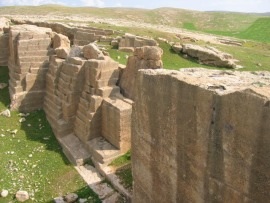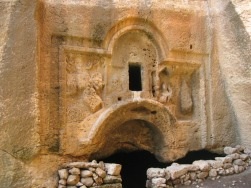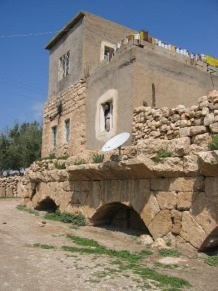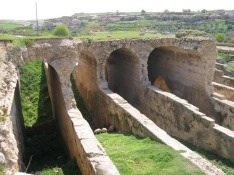Setting for ancient battle Population: 1,000
Old name: Anastasiopolis
Dara lies midway between Mardin and Nusaybin, its ruins scattered around the modern village of Oğuz. It’s one of those remote archaeological sites that invites you to ponder the curious ways of history. Once this was an imposing city, mentioned by ancient historians such as Procopius, then it simply fell off the map of human geography. As recently as 2007 this was a real town that time forgot, not even featuring on many maps of Turkey. Now, inevitably, it has been discovered as an excursion destination from nearby Mardin.
Backstory
The first settlement here appears to have been founded by the Byzantine Emperor Anastasius (491-518), hence its original name of Anastasiopolis. A huge settlement surrounded by a many-towered wall, it should have been able to put up an effective resistance to invaders. However, in the sixth century it found itself right on the frontline in the power struggle between the Byzantines and their Persian neighbours.
In 530 the Byzantine general Belisarius was sent by the Emperor Justinian to drive back the Persians and won a memorable victory at Dara despite being greatly outnumbered.
The Persians fought back under Khosrau I who got the upper hand, conquering the city in 573, an event that was thought to have sent the Byzantine Emperor Justin II mad. In 586 the Byzantines seized the city back, only for the Persians to take it again and sack it in 604.
Rebuilt by the Byzantines in 628, Dara fell to Arab invaders in 639 and remained in their hands until 942.
The Byzantines briefly recovered it but the city eventually became part of the local Artukid fiefdom based in Mardin, before eventually falling to the Ottomans. For the Ottomans, however, it was just a crumbling frontier town of litte significance and so the great city slowly shrunk back into a village.
Around the site
 For modern visitors the fun starts almost as soon as they turn left off the highway from Mardin. Shortly afterwards, in the fields on the left, they see huge stepped stones cut into the fields like inverted ziggurats. This area turns out to be the quarry where slaves cut the stones to build Dara. It’s a beautiful, evocative place, full of wild flowers in spring.
For modern visitors the fun starts almost as soon as they turn left off the highway from Mardin. Shortly afterwards, in the fields on the left, they see huge stepped stones cut into the fields like inverted ziggurats. This area turns out to be the quarry where slaves cut the stones to build Dara. It’s a beautiful, evocative place, full of wild flowers in spring.
Just before the village of Oğuz what looks like a second quarry on the left is actually a sprawling necropolis where the dead of Dara were buried on rock-cut ledges inside rock-cut tombs. Most of these tombs are simple affairs but amongst them are also a few impressively carved monuments to the city’s wealthier inhabitants. Most striking of all is the tomb known to the villagers as the “First Church”. On its façade it is still just about possible to make out carvings of the hand of God, of an angel and of a small building believed to be a church.
Finally, you arrive in the village itself. At the entrance you may be approached by young men with official identity cards who have been trained as guides in an attempt to prevent Dara’s visitors from being frightened away by hordes of inquisitive children. You would be advised to take them up on their offer of help, if only to make sure you see those parts of the site that are generally kept locked.
The main ruins congregate on either side of a dry riverbed traversed by a Byzantine bridge with deep wheel ruts worn into its stonework. On either side of the river stand the sizeable remains of parts of the city wall and of several towers – your guides will also point out what is rumoured to have been a dungeon and the clever drainage channels around the base of the towers.
What was once the agora (marketplace) is now very overgrown but still repays brief inspection.
 Dara’s biggest surprise, however, lies directly underneath a village house with an up-to-the-minute satellite dish on its roof. The boys will unlock the metal gate so that you can descend into a vast cistern which is at least as deep as the famous Yerebatan Cistern in İstanbul. Archaeologists have yet to dig right to the floor of this amazing place but it is an extraordinary, unforgettable find, especially in such an unlikely location. Once a huge church sat astride the cistern; one giant capital from it survives in the nearby tea-house.
Dara’s biggest surprise, however, lies directly underneath a village house with an up-to-the-minute satellite dish on its roof. The boys will unlock the metal gate so that you can descend into a vast cistern which is at least as deep as the famous Yerebatan Cistern in İstanbul. Archaeologists have yet to dig right to the floor of this amazing place but it is an extraordinary, unforgettable find, especially in such an unlikely location. Once a huge church sat astride the cistern; one giant capital from it survives in the nearby tea-house.
Buoyed up by the excitement of the discovery it would be easy to think you’ve seen all that Dara has to offer, but away from the main site there are yet more cisterns to be seen, this time standing exposed and only partially roofed near a simple village tea-house (some believe these structures were actually a granary). Only when you’ve finished wondering at their unbroken stretches of rock wall should you relax and order a glass of çay.
Sleeping
There is nowhere to stay in Dara/Oğuz. The nearest good hotels are in Mardin.
Transport info
There are no buses to Oğuz, so your best bet, without a private car, is to hire a taxi for a half-day excursion from Mardin or conceivably from Nusaybin.


